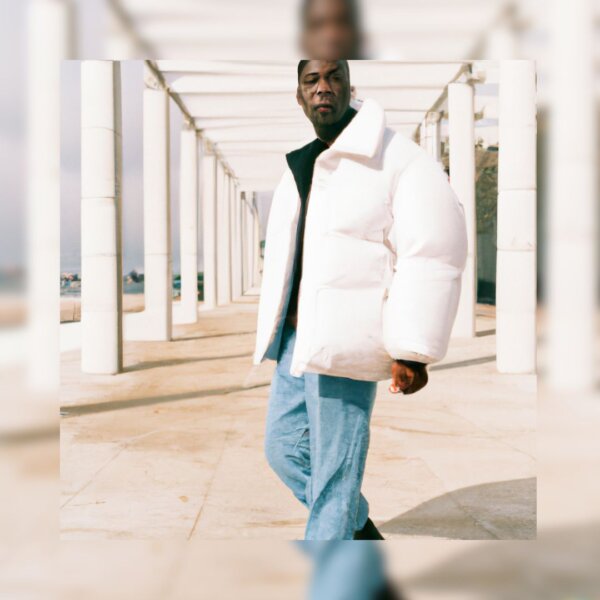Setting the stage: from nasty to tasty, Streetwear and Luxury Fashion’s helm
In the everchanging scenario of fashion these last years, where prominent urban artists have risen to the creative direction of major luxury fashion brands (think of the likes of Nigo at Kenzo, or Pharrell at Louis Vuitton, just to name a few), it’s more than evident the influence of streetwear and Hip-Hop culture over luxury brands.
As a global cultural phenomenon, established in shaping trends and challenging the status quo like no post-modern force before, hip-hop and its derivatives have now become fully integral to the evolution of luxury fashion.
The party didn’t exactly start today, and it wasn’t always a real party, in the broadest sense of the term. Let’s take a look at how it all started and then evolved, shall we?

Tommy Hilfiger collaboration with luxury streetwear brand Aries.
Unveiling the Roots: The Origins of Streetwear
Generally speaking, streetwear is a distinctive style of casual and often unconventional clothing that emerged as a cultural expression, closely tied to the subcultures of skateboarding, graffiti art, and hip-hop, in the innercities of the United States, in the late Seventies and early Eighties. The term “streetwear” itself implies a fashion that is rooted in the streets, reflecting the authenticity and individuality of those who embrace it.
The journey begins in the urban landscapes, where streetwear emerged as a distinct form of self-expression, just like hip-hop. During the 1970s and 1980s, street fashion drew inspiration from the do-it-yourself ethos of punk, mixing elements from the Japanese street style, new wave, heavy metal, and so on.
Some brands were fueled and skyrocketed in sales by the hip-hop emergency: think of the likes of Lee, Puma, and Adidas, first and foremost. Or again traditional old-school fashion labels just like Kangol or Fila. To the hip-hop and street crowd, style mattered as a way of self-elevation and freedom.
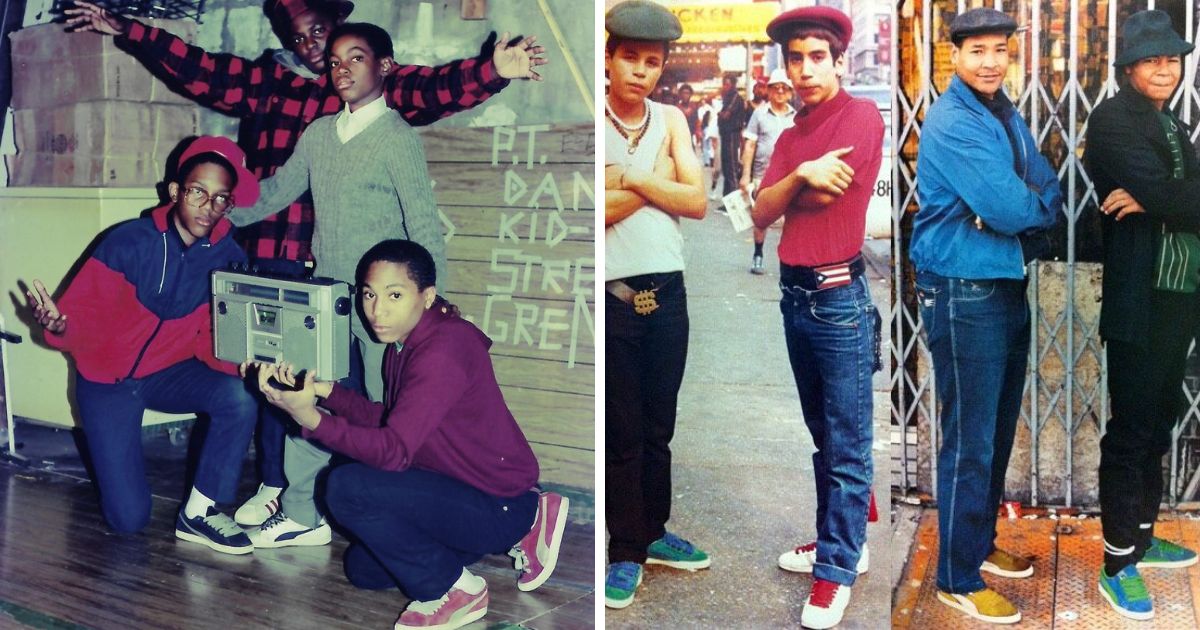
Classic NYC’s innercity shots of old-school b-boys in the early Eighties
No wonder that icons like Run-D.M.C., clad in Adidas tracksuits, laid the foundation for a movement that would eventually redefine the fashion landscape. They were the very first hip-hop act to bring rap music on the then very white/rock-n-roll-driven MTV, helping hip-hop spread globally.
Thanks to their song My Adidas they were also the very first rap act to have an official sponsorship deal with the German company Adidas, which heavily cashed in on the street cred that the group from Hollis, Queens, gave them on the American market. The brand with the three stripes became the most influential and best-selling in America for a long time before Nike managed to take the crown away from it.
And anyway, for rap trivia, after Run DMC gave voice to their love for their shoes, Heavy D & The Boyz winked at Adi’s rival sports giant from Beaverton, Oregon, recording Nike – and if you didn’t know, now you know…

The RUN-D.M.C crew wearing the famous Adidas tracksuits (L to R: Rev. Run, Jam Master Jay, DMC)
Entering the early 1990s, major record labels such as Tommy Boy Records, Def Jam, and Delicious Vinyl began retailing their branded items, incorporating embroidery on letterman and workwear jackets produced by companies like Carhartt.
The style evolved, from tracksuits, caps, sneakers, and gold chains, morphing into big graphic t-shirts, hoodies, and loose sweatpants. The Nineties’ aesthetics came with a new breadth of colours and influences, as new groups and styles of urban art and music went on. And more influences came from the West Coast, too.
In the latter part of the 1980s, Shawn Stüssy, a designer known for surfboards in the beginning, initiated the sale of printed T-shirts bearing his distinctive signature – the same mark found on his custom surfboards. Initially, Stüssy peddled these items from his vehicle, later expanding to stores as their popularity surged. As demand reached its peak, Stüssy deliberately shifted to exclusive sales, establishing a new yet fundamental definition of streetwear, that fashion would pick up later: T-shirts and exclusivity.
By the early 1990s, pioneering brands followed this path and extended their branches influencing of course the rap and skateboarding scene. If you’ve never heard of the likes of Cross-Colors, Planet Earth, SPX, and a slew of others, know that they gave way to oversized explosions and excessively colourful matches.
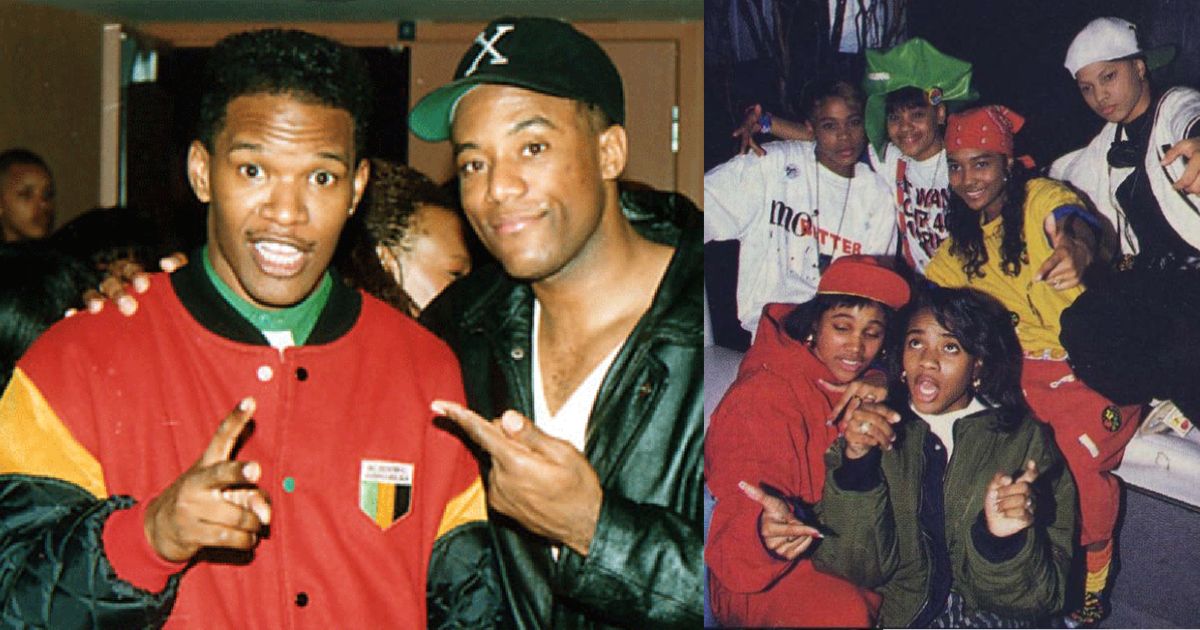
On a similar vibe, yet with a more refined tone, the likes of rising stars such as Grand Puba (the same Puba who has been recently named the most stylish rapper ever by A$AP Rocky, in case you’ve missed it) started embracing and showing off brands such as Polo by Ralph Lauren, Tommy Hilfiger, and Nautica, adjusting their original Americana preppy vibe to the street crowds. Sounds crazy, isn’t it? Well, not really.
We must not forget how the evolution of innnercity youths’ tastes and style coincided with the commercial success of rap and R&B in the charts. The hip-hop community embracing of brands considered until then “white” and “for the rich”, reinterpreting them in an urban key, was in itself a cry of freedom and a statement for the young people of the inner cities, who saw their idols as models of attainable and shared lifestyle.
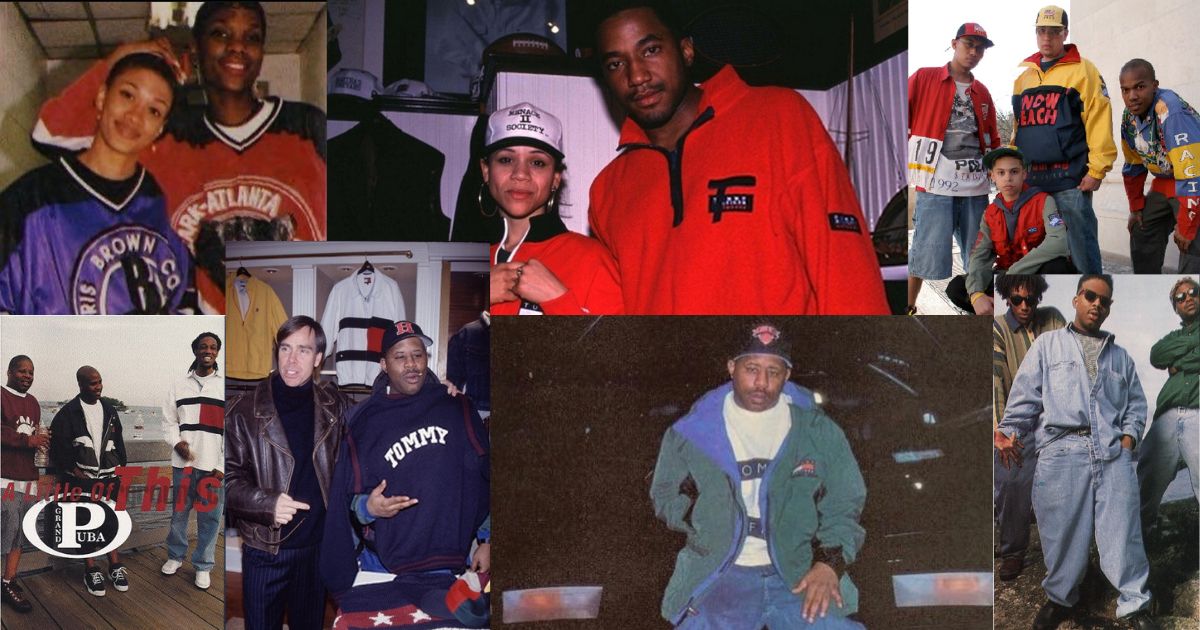
Grand Puba, Tommy Hilfiger, Q-Tip, Rosie Perez, Brand Nubian, the early style masters
Interpreting the need to conjugate a lifestyle touch and “representing” need, corporate America didn’t sleep on the trend, helping it to further spread. The significant contributions from professional American sports franchises, notably the New York Yankees, Los Angeles Raiders, and Chicago Bulls, with their oversized team jerseys, caps, and jackets, along with boots from The Timberland Company and the latest shoe designs from Nike, Inc., left an indelible mark on the scene.
On top of that, alongside the emergence of indie brands and fashionable labels, the trend continued as record label moguls ventured into fashion launches. Russell Simmons of Def Jam introduced his Phat Farm label, Sean Combs of Bad Boy unveiled Sean John, and Jay-Z of Roc-a-Fella Records launched Rocawear. Rapper 50 Cent followed suit, unveiling his G-Unit clothing label through a partnership with entrepreneur and designer Marc Ecko, and securing sneaker rights with Reebok. 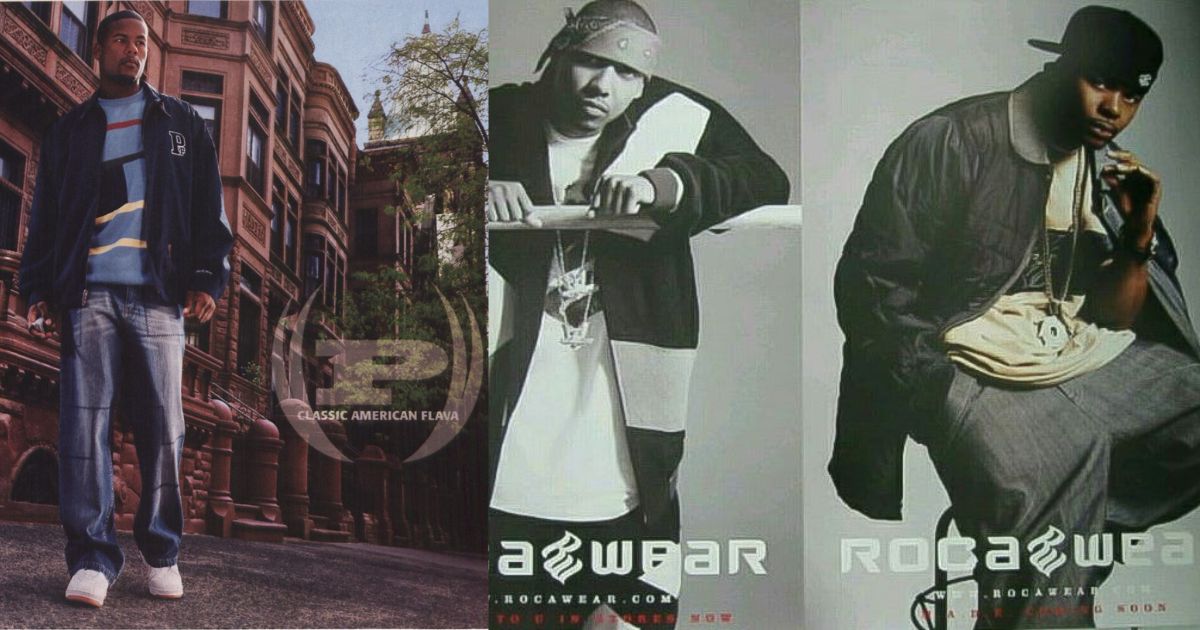 Advertising pages for streetwear brands Phat Farm (L) and Rocawear (R)
Advertising pages for streetwear brands Phat Farm (L) and Rocawear (R)
The Birth of Luxury Streetwear
Defining Luxury Fashion: what is it?
If it’s clear what streetwear is, on the other hand, at the opposite side of the spectrum, time to discuss luxury. Particularly high-end luxury brands embody a commitment to excellence, exclusivity, and exceptional quality. These brands are renowned for producing goods that transcend ordinary standards, offering a combination of craftsmanship, design, and premium materials. Think of symbols of prestige, opulence, and sophistication. Does it sound tremendously hip-hop to you, perhaps? Hold on a second, then.
The Godfather of Street Luxury: The Myth of Dapper Dan
It is nearly impossible to talk about the high-low fashion history and luxury streetwear without mentioning the great Dapper Dan and his pioneering role and entrepreneurial mindset. Dapper Dan, recognized as the “king of knock-offs,” gained prominence in the late ’80s and ’90s as a couturier in Harlem, New York, crafting a signature gangster-inspired style for the emerging scene. His clientele included rap stars, athletes, and gamblers, the likes of Eric B & Rakim, LL Cool J, James Jackson, Mike Tyson, and, more recently, even Floyd Mayweather.
Upon his return from a trip to Africa, he developed an interest in fashion, establishing his 24-hour store in 1982. His unique made-to-order customization model thrived on regular visits to luxury department stores, where he acquired monogrammed hardware as stock. Mainly the likes of Gucci, Fendi, Chanel, and Louis Vuitton. Yes, those were the tastes of the burgeoning clientele, and rightfully so.

Eric B (L) ad Rakim (R) dressed up in classic Dapper Dan’s creations, and a detail from the back cover of “Paid In Full” album
Dapper Dan’s breakthrough moment occurred when he designed outfits for Eric B and Rakim, featured on the cover of their 1987 debut “Paid in Full.” That was when luxury brands took note of Dan’s reworked logo prints, and he faced legal challenges alleging copyright violations. By 1992, a raid on his boutique by Fendi led to the closure of his store, so he returned to selling on the streets faux Chanel t-shirts to private customers for a long while. But he kept always doing productions on demand for big-time hustlers in his circle.
In 2018, a cultural appropriation controversy involving Gucci led to the revival of his business. Gucci’s Cruise 2018 show unveiled a mink bomber jacket reminiscent of Dan’s 1989 creation for Diane Dixon. This garment triggered online backlash for appropriation. While Gucci insisted it was a homage, they later collaborated with Dan on a capsule collection inspired by his archive.
They also released a limited-edition book, “Dapper Dan’s Harlem” and featured Dan in the #GucciTailoring campaign. Gucci further solidified the partnership by opening an invitation-only atelier with Dan, providing fabrics for his new creations.

Gucci and Dapper Dan collaboration.
The Emergence of Streetwear and Luxury Collaborations
Entering Y2K’s, the ascent of the “bling bling” culture welcomed established luxury brands like Burberry, Gucci, and Fendi into the market. These brands made appearances in Hip-Hop music videos and films, with the Nike Air Force 1 emerging as the iconic footwear of the era, immortalized in Nelly’s song.
Luxury brands, often still thought about as symbols of exclusivity and refinement, explored collaborations with streetwear labels, creating a new market named “luxury streetwear.” What sets it apart is the quality of materials and craftsmanship with a touch of the rawness of streetwear. Think of it as the merge of street style and high-end fashion quality.
Iconic collaborations, like the Kanye West x Louis Vuitton capsule of luxury sneakers in 2009, or the Everyone x Vetements collection with a bunch of high-low brand combinations in Spring 2016, emphasized the blending of two seemingly distant universes.
Partnerships such as Supreme x Louis Vuitton, Fila x Fendi, A Bathing Ape x Comme des Garçons, and Stüssy x Dior marked a convergence of different worlds colliding, blurring the lines between the two realms, for real. If on the one hand, the price point of high-end fashion products kept being ridiculously high, a new product range aimed at the street crowd emerged with a more accessible price point, whilst some streetwear fixtures raised their price points.

Louis Vuitton x Supreme collaboration trunk.
Streetwear Icons Shaping the Fashion Narrative
The 21st century witnessed the solidification of the high-low fashion era, so to speak. Streetwear, once confined to subcultures, infiltrated mainstream consciousness, and the clash of street aesthetics with high-end luxury staples marked a seismic shift in the industry, challenging the exclusivity associated with luxury brands before.
No surprise then if influential hip-hop figures have not only shaped streetwear but have also become instrumental in influencing the broader fashion narrative. Pharrell Williams and Virgil Abloh are among those who have bridged the gap between street style and luxury, leaving an indelible mark on the industry. Their unique entrepreneurial spirit and style have become integral to the evolution of the phenomenon, indeed.
Virgil Abloh: style in a brick
Known for his role as the Artistic Director of Menswear at Louis Vuitton and the Chief Executive Officer of his streetwear brand Off-White, Virgil Abloh was not just a designer but also an architect, DJ, engineer, and musician. His distinctive fashion sense appealed to diverse audiences, spanning clothing, footwear, music, and furniture. A creative mind to the fullest, a grown-up hip-hop head, Virgil had an incredible fast rise in the fashion world, also thanks to his partnership with Kanye West, as art director of the creative content label DONDA.
In 2013, one year after launching a brand called Pyrex Vision, he introduced Off-White, a brand infused with street style that gained global acclaim. It made a mark with its recognizable branding, notably the yellow belt resembling a luggage strap. Adding streetwear tones to more intricate designs, Off-White soared in popularity from 2018 to 2021, solidifying its position as one of the pioneers of luxury streetwear fashion. Collaborations with industry giants like Nike and Levi’s further elevated its status.
In 2018, Virgil Abloh made history as the first Black person to lead Louis Vuitton’s menswear ready-to-wear line. His debut collection at Men’s Fashion Week in Paris featured notable figures like Playboy Carti, Steve Lacy, A$AP Nast, Dev Hayes, and Kid Cudi gracing the runway.
Notably, in 2020, Abloh established the LVMH Black Database, a platform showcasing new black talent for collaboration within LVMH. He also launched the LVMH Diversity Panel, advocating for diversity and representation across the company. Abloh’s Louis Vuitton collection, featuring ‘NIGO,’ ‘Heaven on Earth,’ ‘Air Force 1,’ and ‘Amen Break,’ left an indelible mark, capturing the essence of sport, music, and streetwear fashion, setting a template for other brands to follow.
As you all know, the polarising man (loved by many, hated by most) passed away in 2021 due to cancer, leaving an enduring impact on streetwear and luxury. His legacy includes breaking down longstanding barriers in the fashion industry and paving the way for a new generation of designers.

Virgil Abloh holding two pieces of his legendary collaboration between Off-White and Nike.
Pharrell Williams: the N.E.R.D. at the controls
As the most recent artistic Director at LV, Pharrell Williams is a seasoned presence in the fashion arena, boasting a journey that predates his current role. As the co-proprietor of the streetwear brand Human Made, co-owner of G-Star Raw denim, and the originator of iconic streetwear imprints like Billionaire Boys Club and Ice Cream, Pharrell has long been a forward-thinking individual whose imaginative pursuits span the domains of music, art, and fashion, earning him the distinction of a fashion icon.
Despite making a mark in the music industry in the early 2000s, producing some of hip-hop’s most memorable sounds, Pharrell’s appetite for optimal creativity extended beyond conquering the music charts. Following a trip to Japan, where he met and befriended deejay, producer, and entrepreneur Nigo (the actual artistic director of Kenzo, just to keep it right), founder and owner of iconic Japanese brand A Bathing Ape, or BAPE, he started working on his soon-to-be-announced inaugural Billionaire Boys Club collection.
Pharrell played a pivotal role in bringing BAPE’s vibrant colours and graphics to the forefront, helping the brand escalate the US market and gaining worldwide visibility. As he became the face of BAPE in the United States, he matched it with BBC to position his brand right. Smart move, isn’t it?
Pharrell is the imprint for Hip-Hop artists to exert a significant influence on red-carpet fashion, through his distinctive style and presentation. By remaining true to his creative vision, he consistently donned some of the most attention-grabbing outfits in music, seamlessly integrating with his collaborators.
The untimely passing of Virgil Abloh left an irreplaceable void in the fashion world, particularly at Louis Vuitton. Pharrell Williams’ appointment as his successor carries considerable significance, given Abloh’s groundbreaking impact that redefined luxury fashion, making it more accessible to a broader audience.
Pharrell, committed to upholding the spirit of innovation and inclusivity, aims to pay tribute to Abloh’s groundbreaking work while steering Louis Vuitton into a new chapter in the fashion domain. Pharrell’s inaugural Spring 2024 Men’s Collection, made a splash by setting records with over 1 billion views globally.
And if you looked at the event’s carpet, the pictures and videos from the show, and the press the show had, the whole thing looked like a who’s who in hip-hop, or a BET Award night in its best day. He brought all his friends and business partners to celebrate and have extra coverage. That’s hip-hop.
Streetwear: A Catalyst for Business Revitalization?
While the collaboration between streetwear and luxury has produced remarkable results, challenges abound. Luxury brands navigate the delicate balance of maintaining exclusivity while reaching a broader audience. Striking this equilibrium is pivotal as brands seek to retain their prestige while embracing the democratic ethos of streetwear. Add to this that the younger urban crowds are very volatile, and harder to impress than their parents in the Eighties and Nineties.
The Hype Drops: Streetwear’s Economical Impact on Luxury
The economic impact of streetwear on luxury brands is undeniable. Hyped releases, strategic collaborations, and limited-edition drops contribute not only to revenue spikes but also to the overall brand visibility and relevance. Fashion clothing manufacturers adopted the streetwear concept, introducing very limited-edition capsule collections, commonly known as “drops“, utilizing social media and product scarcity as integral marketing tools.
These limited-edition releases became the cornerstone of streetwear’s allure. Scarcity, combined with innovative designs, created an air of exclusivity that fueled hype and demand. This model, while driving economic success, also raised questions about sustainability, accessibility, and ethical production.
The secondary market for streetwear, fueled by reselling platforms and vintage stores, has become a lucrative industry. Rare and hyped items fetch astronomical prices, creating a unique economy that challenges the traditional retail model.
A Street-driven Visual Revolution
Fashion runways, once reserved for haute couture, experienced a visual revolution as streetwear aesthetics took center stage. Streetwear-inspired collections challenged traditional runway norms, injecting raw, authentic energy into high-end fashion. The catwalks transformed into a dynamic showcase, embracing the diversity and dynamism of street culture.
Beyond clothing, streetwear has disrupted traditional fashion show formats, pushing for more immersive and unconventional runway presentations and ideas. Let’s highlight here the memorable Moncler Genius 2023 fashion showcase with Alicia Keys, Jay-Z, Pharrell Williams, and Little Simz, just to name a few. And, for the rap trivia, Little Simz has also been recently featured on the cover of Vogue Magazine. Just sayin’…

Alicia Keys, Little Simz, and Cleo Sol performing during the Moncler Genius Fashion Show.
Consumer Shift: The Rise of Authenticity and Activism
As the fashion landscape evolved, consumers sought more than just garments; they sought authenticity. More than ever, in a way. Streetwear, rooted in individual expression, became a symbol of genuine self-representation. The demand for fashion that resonates on a personal level surged, marking a significant shift from conspicuous consumption to meaningful self-expression.
Controversies and Criticisms
As the worlds of streetwear and luxury collide, controversies emerge. Cultural appropriation concerns, criticisms of excessive hype, and ethical considerations in production have sparked debates within the fashion community.
Collaborations between luxury brands and streetwear labels sometimes walk a fine line, raising questions of cultural appropriation. Sensitivity and awareness are crucial to navigating this terrain and avoiding inadvertent missteps.
Moreover, the tension between maintaining exclusivity and embracing inclusivity is an ongoing debate. Luxury brands must strike a delicate balance, ensuring that collaborations and releases appeal to a broad audience without diluting the essence of their brand.
As societal awareness grows, sustainability is also a focal point in both streetwear and luxury. Consumers demand ethical practices, prompting brands to adopt eco-friendly initiatives. This shift represents a collective responsibility to tread lightly on the planet, emphasizing the significance of mindful consumption.
Streetwear and Luxury: A Continued Evolution
No matter how and what, in the present day, the fusion of streetwear and luxury continues to captivate fashion enthusiasts. Collaborations between established luxury brands and emerging streetwear labels redefine trends, showcasing the enduring appeal of the high-low fashion movement. The narrative is ever-evolving, reflecting the dynamic nature of both industries.

The latest streetwear and luxury collaboration between Comme des Garçons and Freitag.
A Glimpse Ahead: An Everlasting Impact
Looking ahead, the trajectory of streetwear and luxury fusion appears dynamic. Innovations in design, materials, and marketing will likely shape the future landscape. Anticipating shifts in consumer behaviour, the fashion industry prepares for a continued evolution of the high-low fashion era, promising exciting trends and collaborations on the horizon.
Even though UK editor Nav Gil of Hypebae says that it’s hard to predict where streetwear will go next.
“Streetwear has always been of the moment. Will there continue to be a burst of high-end brands producing massive oversized hoodies? Maybe. At the end of the day, fashion has its moments with what they think is cool at the time. Of course, it might get oversaturated and then not cool anymore. It might then go back to the streets and people might start their small streetwear brands again. And it’ll come back around again.”
In conclusion, the coming up of streetwear and luxury brands is not just a trend; it’s a cultural shift that has redefined the fashion landscape. From its humble origins on the streets to its current position as a global phenomenon, streetwear’s impact is undeniable. As we navigate the ever-evolving narrative of high-low fashion, one thing is certain—the influence of streetwear on luxury brands is a story that continues to unfold.
